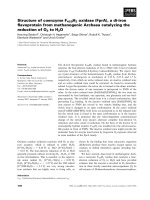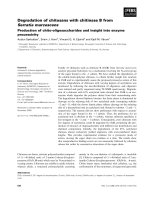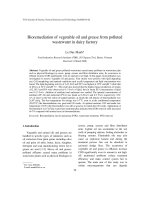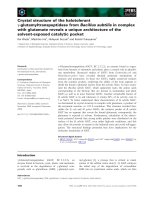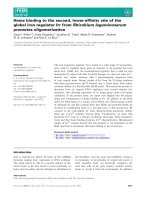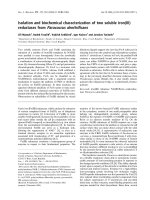Master Thesis of. Direct Reduced Iron Production from EAF Slags in Fixed Bed Furnace. Idil Bilen. Jan, 2013. Supervisors_
Bạn đang xem bản rút gọn của tài liệu. Xem và tải ngay bản đầy đủ của tài liệu tại đây (2.4 MB, 65 trang )
Master Thesis
of
Direct Reduced Iron Production from EAF
Slags in Fixed Bed Furnace
Idil Bilen
Jan, 2013
Supervisors:
Prof. Pär Jönsson
Prof. Onuralp Yücel
Royal Institute of Technology, Materials Science Department, Stockholm
Istanbul Technical University, Metallurgical and Materials Engineering
Department, Istanbul
To My Mother…
ii
ACKNOWLEDGEMENT
This master thesis work has been prepared in Royal Institute of Technology, Department of
Materials Science and Istanbul Technical University Prof. Dr. Adnan Tekin Applied Research
Center of Materials Science and Production Technologies. I would like to express my
gratitude to Prof. Onuralp Yücel and Prof. Pär Jönsson for this opportunity to work in an
internationally collaborated study and of course for training me with patience during this
master thesis study.
I would also thank to Assoc. Prof. Anders Eliasson, for his guidance to all my confusions and
problems during my master studies and Research Assistant Ahmet Turan for all his great
effort and support every time during my work in the laboratory, literature study of this thesis
and even for conversations about daily life, he has been a brother to me.
I thank to Research Assistant Murat Alkan especially his help for XRD studies and Chemist
Bihter Zeytuncu and Chemist Hakan Morcalı for their contribution to chemical analysis of
every single sample in this study.
I especially thank to Assoc. Prof. Andrey Karasev and Assoc. Prof. Bora Derin for their
kindness and time for defense of this thesis work during The 30th International Steel
Industry Conference in Paris, France.
I thank to all my colleagues especially to MSc. Aslı Burcu Üstünova that I shared laboratories,
office, conversations, lunchtimes and a valuable friendship since 2006.
Also I would like to thank to Edip Kavvas, he has been always exactly where I need him for
any case. I thank him for all love, happiness and joy that he has brought to my life.
I am grateful to all my family, especially to my mother Nazife Bilen, my brother Ödül Birge
Bilen and my aunt Gülşen Toksöz, they have done a lot more than just giving their love to
me at all time. They have lighted my way and made me who I am today.
Idil Bilen
Jan, 2013
iii
iv
CONTENTS
ACKNOWLEDGEMENT ....................................................................................................................... iii
CONTENTS................................................................................................................................................. v
ABBREVIATIONS .................................................................................................................................. viii
LIST OF FIGURES ................................................................................................................................... ix
LIST OF GRAPHS...................................................................................................................................... x
LIST OF TABLES ..................................................................................................................................... xii
ABSTRACT ............................................................................................................................................... xiii
1.
INTRODUCTION ............................................................................................................................ 1
2.
MOTIVATION OF THE STUDY ................................................................................................. 3
3.
LITERATURE STUDY .................................................................................................................... 4
3.1
Direct reduction of Iron oxide .................................................................................................. 4
3.2
Reactions of Iron Oxide reduction process ............................................................................. 5
3.3
Usage area of direct reduced iron .............................................................................................. 8
3.3.1
Direct reduced iron usage in EAF .................................................................................... 8
3.3.2
Direct reduced iron usage in Blast Furnace ..................................................................... 8
3.3.3
Direct reduced iron usage in Casting Furnace ................................................................ 9
3.3.4
Usage of DRI in EAF, BOF and casting cupola as coolant ......................................... 9
3.4
Direct Reduction Technologies ................................................................................................. 9
3.4.1
Products of Direct Reduction ......................................................................................... 10
3.4.1.1
Direct Reduced Iron ................................................................................................. 10
3.4.1.2
Hot briquetted iron ................................................................................................... 10
3.4.1.3
Cold briquetted iron ................................................................................................. 11
3.4.2
Direct Reduction Technologies....................................................................................... 11
3.4.2.1
Gas reductant based direct reduction processes................................................... 11
3.4.2.2
Solid reductant based direct reduction processes ................................................. 14
v
4.
EXPERIMENTAL STUDIES ....................................................................................................... 19
4.1
4.1.1
Electric Arc Furnace Slag ................................................................................................. 19
4.1.2
Reducing Agent ................................................................................................................. 20
4.1.3
Binder .................................................................................................................................. 20
4.2
Equipment .................................................................................................................................. 20
4.2.1
Fixed Type Bed Furnace .................................................................................................. 21
4.2.2
Raw Material Preparation ................................................................................................. 21
4.2.3
Characterization ................................................................................................................. 22
4.3
5.
Materials ...................................................................................................................................... 19
Design of Experiments ............................................................................................................. 22
RESULTS AND DISCUSSION .................................................................................................... 26
5.1
Experiment Parameters ............................................................................................................ 26
5.2
Chemical Analysis Results ........................................................................................................ 26
5.2.1
Effect of Experiment Temperature ................................................................................ 29
5.2.1.1
Comparison of experiments that was performed by 1,5 times
stoichiometrically required metallurgical coke .......................................................................... 30
5.2.1.2
Comparison of experiments that was performed by 2,0 times
stoichiometrically required metallurgical coke .......................................................................... 31
5.2.2
5.3
Effect of Reducing Agent Amount ................................................................................ 32
XRD Results ............................................................................................................................... 34
5.3.1
Dependence of Phases in the Samples on Duration .................................................... 34
5.3.2
Effect of Temperature ...................................................................................................... 37
5.3.2.1
Comparison of experiments that was performed by 1,5 times
stoichiometrically required metallurgical coke .......................................................................... 37
5.3.2.2
Comparison of experiments that was performed by 2,0 times
stoichiometrically required metallurgical coke .......................................................................... 38
5.4
6.
Optical Analysis Results............................................................................................................ 39
5.4.1
Dependence on Duration ................................................................................................ 39
5.4.2
Effect of Temperature and Reducing Agent Amount ................................................. 40
CONCLUSIONS .............................................................................................................................. 42
vi
7.
REFERENCES ................................................................................................................................. 44
8.
APPENDICES .................................................................................................................................. 47
vii
ABBREVIATIONS
AAS
DRI
EAF
ITmk3
HBI
CBI
XRD
XRF
BOF
TDR
EIF
: Atomic Absorption Spectrometry
: Direct Reduced Iron
: Electric Arc Furnace
: Iron Making Technology Mark 3
: Hot Briquetted Iron
: Cold Briquetted Iron
: X-Ray Diffraction
: X-Ray Fluorescence
: Basic Oxygen Furnace
: Tisco Direct Reduction
: Electric Iron Furnace
viii
LIST OF FIGURES
Figure1. Gradual reduction of iron oxide ................................................................................................. 5
Figure2. Baur-Glaessner Diagram is given with Bouduard reaction curve .......................................... 7
Figure3. Baur-Glaessner diagram for CO/CO2 and H2/H2O atmospheres........................................ 7
Figure4. Flow Chart of MIDREX Process............................................................................................. 13
Figure5. Flow Chart of FINMET Process ............................................................................................. 14
Figure6. Flow Chart of SL/RN Process ................................................................................................. 15
Figure7. Flow Chart of TDR Process ..................................................................................................... 16
Figure8. Flow Chart of FASTMET Process .......................................................................................... 37
Figure9. Flow Chart of ITmk3 Process .................................................................................................. 48
Figure10. a) EAF slag, b) Metallurgical coke, c) Molass ....................................................................... 19
Figure11. Protherm laboratory type fixed type bed furnace ................................................................ 21
Figure12. Laboratory type 40 cm diameter pelletizing disk and pellets ............................................. 21
Figure13. XRD analysis of EAF slag ....................................................................................................... 22
Figure14. Graphite boat ............................................................................................................................ 23
Figure15. Graphite boat and the reaction products after furnace experiment .................................. 24
Figure16. 20X magnified micro photos of samples with 2,0 stoichiometrically added coke and
1150°C ......................................................................................................................................................... 47
Figure17. 20X magnified micro photos of samples at 90th minute ..................................................... 41
ix
LIST OF GRAPHS
Graph1. Particle size distribution of grinded slag ................................................................................. 23
Graph2. Metallic iron, 2 and 3 valency iron distribution in the samples prepared with 1.5 times
stoichiometrically required coke addition at 1050°C ............................................................................ 27
Graph3. Metallic iron, 2 and 3 valency iron distribution in the samples prepared with 2,0 times
stoichiometrically required coke addition at 1050°C ............................................................................ 27
Graph4. Metallic iron, 2 and 3 valency iron distribution in the samples prepared with 1,5 times
stoichiometrically required coke addition at 1100°C ............................................................................ 28
Graph5. Metallic iron, 2 and 3 valency iron distribution in the samples prepared with 2,0 times
stoichiometrically required coke addition at 1100°C ............................................................................ 28
Graph6. Metallic iron, 2 and 3 valency iron distribution in the samples prepared with 1,5 times
stoichiometrically required coke addition at 1150°C ............................................................................ 29
Graph7. Metallic iron, 2 and 3 valency iron distribution in the samples prepared with 2,0 times
stoichiometrically required coke addition at 1150°C ............................................................................ 29
Graph8. Metallization degree of include1,5 times stoichiometrically required metallurgical coke
samples with respect to temperature and duration................................................................................ 30
Graph9. Metallization degree of include 2,0 times stoichiometrically required metallurgical coke
samples with respect to temperature and duration................................................................................ 31
Graph10. Metallization comparison of 1,5 and 2,0 times stoichiometrically required metallurgical
coke added experiment results at 1050°C ............................................................................................... 19
Graph11. Metallization comparison of 1,5 and 2,0 times stoichiometrically required metallurgical
coke added experiment results at 1100°C ............................................................................................... 26
Graph12. Metallization comparison of 1,5 and 2,0 times stoichiometrically required metallurgical
coke added experiment results at 1150°C ............................................................................................... 42
Graph13. Phase transformations depending on duration of the samples at 1050°C with 1,5 times
stoichiometrically required coke addition ............................................................................................... 35
Graph14. Phase transformations depending on duration of the samples at 1050°C with 2,0 times
stoichiometrically required coke addition ............................................................................................... 35
x
Graph15. Phase transformations depending on duration of the samples at 1100°C with 1,5 times
stoichiometrically required coke addition ............................................................................................... 35
Graph16. Phase transformations depending on duration of the samples at 1100°C with 2,0 times
stoichiometrically required coke addition ............................................................................................... 36
Graph17. Phase transformations depending on duration of the samples at 1150°C with 1,5 times
stoichiometrically required coke addition ............................................................................................... 36
Graph18. Phase transformations depending on duration of the samples at 1150°C with 2,0 times
stoichiometrically required coke addition ............................................................................................... 44
Graph19. Temperature comparison of three samples prepared with 1,5 times stoichiometrically
required metallurgical coke at 60th minute .............................................................................................. 37
Graph20. Temperature comparison of three samples prepared with 2,0 times stoichiometrically
required metallurgical coke at 60th minute .............................................................................................. 38
xi
LIST OF TABLES
Table1. Features of direct reduced iron .................................................................................................. 10
Table 2. Most common direct reduction technologies ......................................................................... 11
Table 3. Chemical analysis of EAF Slag.................................................................................................. 20
Table 4. Chemical analysis of metallurgical coke ................................................................................... 20
Table 5. Design of experimental parameters .......................................................................................... 25
Table A.1. Chemical analysis results of samples prepared with 2,0 times stoichiometrically coke
addition at 1150°C...................................................................................................................................... 47
Table A.2. Chemical analysis results of samples prepared with 1,5 times stoichiometrically coke
addition at 1150°C...................................................................................................................................... 48
Table A.3. Chemical analysis results of samples prepared with 2,0 times stoichiometrically coke
addition at 1100°C...................................................................................................................................... 49
Table A.4. Chemical analysis results of samples prepared with 1,5 times stoichiometrically coke
addition at 1100°C...................................................................................................................................... 50
Table A.5. Chemical analysis results of samples prepared with 2,0 times stoichiometrically coke
addition at 1050°C...................................................................................................................................... 19
Table A.6. Chemical analysis results of samples prepared with 1,5 times stoichiometrically coke
addition at 1050°C...................................................................................................................................... 52
xii
ABSTRACT
Electric arc furnace (EAF) slags are basic characteristic slags that include approximately 40 %
iron oxide compounds. Iron oxide can be recycled and re-used in the process to decrease amount
of waste product besides reducing loss of raw materials. According to result of survey performed
by The European Association Representing Metallurgical Slag Producers and Processors
(EUROSLAG) in 2010, 8.5 million tons of EAF slag is produced in Europe. High percentage of
EAF slag is re-used in road construction as aggregate. However it can be re-cycled in the internal
use for metallurgical processes as well. In order to re-use EAF slag in the process as a raw
material, direct reduction is a new approach. Direct reduction is reduction of iron containing raw
materials with gas or solid reductants without melting of charge. In this study, reduction
conditions of 39 % Fe2O3 containing EAF slag in tube furnace was examined. As the reducing
agent, metallurgical coke was used. EAF slag was milled and pelletized in raw material
preparation step. Pellets were charged to fixed bed type tube furnace in a graphite boat at 1050,
1100 and 1150°C respectively with 150 and 200% of stoichiometrically required amount of
metallurgical coke. 5, 10, 15, 30, 60, 90 and 120 minutes process durations were performed.
Direct reduced pellets were milled to be characterized by using X-Ray Diffraction (XRD) and
chemical analysis methods. Results indicate that increased temperature, process duration and
stoichiometry have a positive impact on direct reduction of EAF slag in terms of iron
metallization. 90 % metallization degree has been achieved as the result of the study with the
process conditions of 200 % stoichiometry and 90 minutes process duration at 1150 °C.
Keywords: Direct reduction, direct reduced iron, EAF slag, metallic iron production, iron oxide,
steel plant by product.
xiii
1. INTRODUCTION
Nowadays, a major part of steel is produced in integrated plants which have a high productivity
and unlimited production of various steel qualities. On the other hand, due to disadvantages of
integrated steel plants such as high investment cost, electric consumption and environmental
issues, steel producers started to seek an alternative production process. As the second
cornerstone of iron and steel production, electric arc furnace (EAF) became prominent according
to its low investment cost, availability in low productions and no need to secondary plants such
as sinter and coke plants. Related to advantages of EAF, iron and steel industry grow mostly
based on EAF[1,2].
Using scrap as the main raw material charge in EAF has disadvantages as unstable composition
of scrap, limited availability, abrupt cost changes of scrap etc. As a result of negativeness of scrap
usage in EAF, as a cleaner and EAF friendly raw material direct reduced iron will have an
important place in iron and steel industry[3]. Direct reduced iron is a product that is obtained by
reducing iron containing raw materials and waste products by using hydrocarbons or carbon
containing solid reductants, without melting. The final product has a high amount of metallic
iron. Direct reduced iron can be charged to EAF with scrap or can be instead of scrap it can be
used as raw material. Addition to that, in order to increase productivity, eliminate the problems in
production and to provide the desired conditions for production, direct reduced iron can be
charged to blast furnace, basic oxygen furnace (BOF) and casting furnaces. By integrating direct
reduction plants with secondary plants for melting step, those plants may be able to final product
besides the raw material production for other production plants. Consequently, an easier
production compared to blast furnace in the sense low cost and usage of raw material without
preparation[1,3,4].
However, as a result of increasing demand on EAF furnace usage, necessity of direct reduced
iron is increased as well. The growth in steel production leads problems in providing raw
material. Besides, during recent years, in the existed and newly built up EAF plants requires a
cleaner steel production. Due to these reasons, amount of scrap and pig iron is not enough to
compensate the growth in steel industry and the raw material need is satisfied with direct reduced
iron[3].
1
In this study carbo-thermic reduction conditions of EAF slag were observed. EAF slag is a waste
product of steel production that contains various oxides including a high amount of iron oxide.
Experimental set was prepared based on duration, temperature and reductant amount variables
and experiments were performed in a fixed bed furnace. Final products which were obtained
from the experiments were characterized with different analysis methods and results are expected
to define the optimum reduction conditions of iron oxide in EAF slag and lead to light the way
of re-use iron containing waste products.
2
2. MOTIVATION OF THE STUDY
As mentioned in the introduction, crude steel production is provided mainly in integrated steel
plants and EAF plants. Approximately 56% of crude steel in integrated steel plants and 43% of it
was produced in Europe in 2010. Relatively small amount of production was performed in open
hearth furnace plants. Production in EAF is expected to have a larger place in steel world due to
its cost and environmental advantages. But the increased demand on EAF will lead to necessity
of scrap at the same time and higher import rate of scrap in Europe last 10 years[3,5].
Increased need of scrap may cause some problems; first of all scrap is not a produced raw
material and it has a limited increase to meet the scrap need. Scrap as waste product is related to
amount of steel of production and number of recycled scrap comes from the previous
productions. On the other hand, the metallic remaining in scrap has a negative effect in
producing high purity steel in EAF[3].
Pig iron and direct reduced iron are available to be used in EAF plants in order to produce pure
steel with scrap or instead of it. It must be considered that, producers would prefer to use the hot
metal in steel production rather than pig iron production. When the limited options in raw
material selection for EAF taken into account, it can be said that the direct reduced iron usage
will be higher in the near future[3].
Nowadays based on the advantages of direct reduced iron, there is a rising trend in its production
in the world. In direct reduced iron production various type of raw material and manufacturing
methods were developed in previous studies. As raw material mainly iron ore, ore powder or
pellets are used in commercial processes. But it was observed that EAF slag has approximately
40% iron oxide content. In normal procedure, the EAF slag is sent to magnetic separation to take
out the iron particles while the iron oxide is used as aggregate or stored as waste with the rest of
the oxides. Once it is thought that in 2010 around 8.5 mt of EAF slag was obtained in Europe, it
will be a prominent candidate as raw material to be used in direct reduction process. Additionally,
rising demand on steel production in EAF plants will cause to provide a higher amount of EAF
slag in the future[3].
3
3. LITERATURE STUDY
3.1 Direct reduction of Iron oxide
Direct reduction is a process of iron oxide reduction without melting by using hydrocarbon gases
or carbon including materials. Direct reduced iron as the product of the reaction is a slag
containing solid with a high degree of metallization.
Steps of the iron oxide reduction reactions:
The main steps of the reaction can be listed as below:
1. Mass transfer of the reducing gas through the oxide surface in the reduction atmosphere.
2. Diffusion of the reducing gas through the reaction region by keeping the channels in the
oxide.
3. Chemical reaction inside the oxide.
4. Transfer of produced gas as a result of reaction through the outer oxide surface by
channels inside the oxide.
5. Mass transfer of produced gas through the reduction atmosphere[4].
It has been observed that, when the reduction behavior of wustite (FeO) was examined, it occurs
in four steps. At the first step, reaction on the wustite surface, leads to get a supersaturated solid
solution in metal ions terms by sending away the oxygen atoms. In the following step, a metal
core forms in the wustite structure. At the next step, metal ions and electrons in the
supersaturated wustite are transferred to newly formed metal core. At the last step, metal ions
and electrons move to metallic phase from wustite[11]. Gradual reduction of iron oxide is
demonstrated as schematically in the figure 1.
Two different reaction mechanisms are operative when iron oxide powder reduction by carbon
containing powder is examined. The reaction called direct reduction based on the diffusion at the
contact surface of the two reactant, iron and carbon. Indirect reduction reaction is provided by
transformation of CO and CO2 gas phases. Reaction between two solid phases can only be
possible at the contact points and the solid phase reactions end when one of the solid phases
gasify[11,12].
4
Iron oxide-carbon composites are formed by pelletizing of iron oxide and reductants together. In
these composites, reduction reactions occur step by step respective from hematite (Fe2O3),
Magnetite (Fe3O4), wustite to metallic iron (Fe)[13].
Figure1. Gradual reduction of iron oxide[7]
3.2 Reactions of Iron Oxide reduction process
Reactions of iron oxide reduction occur as based of the following equations[14,15];
3Fe2O3 + CO → 2Fe3O4 + CO2
(Eq.1)
Fe3O4 + CO → 3FeO + CO2
(Eq.2)
FeO + CO → Fe + CO2
(Eq.3)
3Fe2O3 + C → 2Fe3O4 + CO
(Eq.4)
Fe3O4 + C → 3FeO + CO
(Eq.5)
FeO + C → Fe + CO
(Eq.6)
3Fe2O3 + H2 → 2Fe3O4 + H2O
(Eq.7)
Fe3O4 + H2 → 3FeO + H2O
(Eq.8)
FeO + H2 → Fe + H2O
(Eq.9)
C + O2 → CO2
(Eq.10)
5
CO2 + C → 2CO
(Eq.11)
(Eq.10) is combustion of carbon equation and (Eq.11) is called Boudouard equation. Carbon
monoxide production is obtained by these reactions. Boudouard reaction is an endothermic
reaction and it has high activation energy; therefore this reaction can progress only at high
temperature[12].
Baur-Glaessner Diagram demonstrates temperature, CO/CO2 and H2/H2O ratio to balance the
free energy change of reduction reactions of iron oxides. In figure 2 Baur-Glaessner Diagram is
given with Bouduard reaction curve and in figure 3, Baur-Glaessner Diagram is given with the
reactions of carbon monoxide and hydrogen as the reductant.
Reduction of iron oxide occurs at the oxide surface heterogeneously by gases like CO and H2.
The surface available to reaction is in the channels inside of the porous iron oxide. In this case,
the reducing gases must enter to channels before they react.
Therefore, efficiency of the
reduction is depending on the structural properties such as channel length and distribution as
well as porosity[4].
When the reduction of hematite with hydrogen is observed, it is seen that reaction moves
topochemically and the partially reduced product forms layers around the hematite core. Above
575°C, wustite become stable, and the layers in the structure are defined as from outside to
inside, magnetite wustite and iron respectively.
Reduction of hematite with hydrogen can be categorized in 3 regimes. In the first regime,
reduction occurs inside the structure. This reaction is effective at low reduction temperature and
small particle size but the rate of reduction is independent from particle size. At the end of the
reaction a homogenous composition is obtained. In the second regime, gas diffusion is active in
reduced iron layer. In this step large particle size and high temperature limits the reaction rate and
rate is dependent to diffusion. Rate starts to decrease while the core diameter is decreasing. An
interface is exist between reaction rely on topochemical model and reaction independent from
topochemical model. The last regime is a controlled regime and transition duration between the
other two regimes. Particle size has a negative effect on reduction reaction rate in the third
regime[17].
6
Temperature, °C
Figure2. Baur-Glaessner Diagram is given with Bouduard reaction curve[16]
Figure3. Baur-Glaessner diagram for CO/CO2 and H2/H2O atmospheres[18].
7
Over 1000°C, the dominant reactions are gas based reduction reactions of iron containing
phases. Above 1000°C, CO and H2 formation reactions from CO2 and H2O (water vapor) occur
which lead to an increase in reduction potential of the gas in the system. Metallic iron absorbs
carbon in the environment above 1200°C and the formed phase can melt below the melting
temperature. Wherefore, 1200°C defines the border between direct reduction and melting
procedure. But in practical terms, carbon absorption becomes faster in melting process over
1300°C[19].
3.3 Usage area of direct reduced iron
3.3.1 Direct reduced iron usage in EAF
Direct reduced iron can be used as iron containing raw material in EAF as to be melted and
converted into liquid steel. There are some advantages of direct reduced iron usage as charge
despite of scrap. First of all, DRI offers a homogeneous chemical compound of the charge and
low gangue elements which leads to make easier to control of steel qualifications. Opposite of
scrap, DRI can be charged directly from the opening of the furnace roof which provides an
effective charging without turning power of and open the furnace roof. As a result of that, a
stable arc and an increase in the average power applied to charge can be obtained. DRI does not
need any preparation to get the homogeneous melt. Also the appropriate shape of DRI provides
an easy charging procedure and prevents of electrode breaking. Since DRI denser than scrap,
with less charge shifts, furnace can be fed that lowers the charging time and as a result of that,
there will be a positive impact on efficiency. As another advantage of DRI usage in EAF, it
promotes the foamy slag formation that reduces harsh effect of arc radiation[1].
Besides the advantages of DRI, there are some disadvantages of decreasing the scrap amount in
charge. DRI requires more energy than scrap to be melted which results in increased electrode
and power consumption. This situation also ends up with longer tap to tap time. Additions to
that, DRI charge without an appropriate amount of scrap in the furnace at the beginning of the
process, makes defenseless the furnace wall and roof to electric arc radiation[20].
3.3.2 Direct reduced iron usage in Blast Furnace
DRI may be used in case of increasing production, compensate the demand and if there is any
trouble in coke plant, to recover the production lost in the blast furnace. Since the coke in the
blast furnace, consumed for oxide removal, when DRI charged to blast furnace, coke required
for oxide removal can be used for melting which leads to lower coke consumption[1].
8
However, experimental study done by Kaushik and Fruehan (2006) indicated that, hot
briquetted iron and DRI charged to blast furnace, may be re-oxidized during the process.
Highly porous DRI re-oxidized more that hot briquetted iron due to higher density of HBI[21].
3.3.3 Direct reduced iron usage in Casting Furnace
Direct reduced iron can be used in casting plants despite of scrap due to its advantages to scrap.
Initially, since DRI has a more stable composition than scrap, it can provide higher purity in the
final product. Therefore it may be more preferable in the processes which require a high purity
such as gray cast iron, ductile cast iron and nodular cast iron. Additionally, DRI provides
easiness in the process that needs to be charged continuously due to its appropriate shape. As a
result of increased DRI usage and producing a better slag, more efficient phosphorus and sulfur
removal can be achieved[1].
Even though the advantages of DRI, usage of DRI in casting processes is not widespread. This is
caused by the inappropriate oxide and gangue element level of DRI that reduces the melting
efficiency and increases the required power and time of the process. Also the iron oxide content
of DRI causes formation of foamy slag that is not desired in induction, cupola and reverb
furnaces contrary to EAF. Addition to that, metallic iron can be oxidized and lost in the slag
phase due to porous structure of DRI[1].
3.3.4 Usage of DRI in EAF, BOF and casting cupola as coolant
In order to balance the temperature increase in EAF, BOF and casting furnace as a result of
exothermic reactions, DRI can be used to cooling charge. Especially, DRI which produced to
meet the requirements of the process, such as appropriate particle size and density, can cool the
furnace to desired temperature without a negative effect to process[1].
The study done by Pastucha et al. indicates that charging of HBI to BOF has the same cooling
effect with scrap. In case of charging HBI despite of scrap, it had been observed that purity of
the final product was increased as well as better sulfur and phosphor removal was achieved[22].
3.4 Direct Reduction Technologies
Direct reduction technologies are process conversion of iron containing raw materials and iron
and steel by products with direct reduction into products that have high metallization. Besides
the usage of direct reduced iron in integrated steel plants or EAF plants, it can be used as final
product. Direct reduction processes can be evaluated as alternative iron production method
9
according to its availability in economical case. In addition, increasing demand on steel
production by EAF leads to rise the attention on direct reduced iron concurrently[1].
3.4.1 Products of Direct Reduction
Direct reduced iron containing raw materials can gain different properties after reduction by
applying different procedures. The general properties of direct reduced iron are given in the table
1. As a result of cooling the product obtained after direct reduction is called direct reduced iron.
If the product after direct reduction, briquetted as hot, it is named as hot briquetted iron and the
product that is briquetted after cooling than it is called cold briquetted iron[23].
TABLE1. Features of direct reduced iron[1].
Feature
Value
Density
1,5 - 4,0 g/cm3
Packing density
1,5 - 1,9 ton/m3
Surface area
0,5 - 4,0 m2/g
Compression strength
50 - 110 kg/cm2
Metallization ratio
% 90 - 95 (ave. % 91 - 93)
Metallic iron %
~ % 85
3.4.1.1 Direct Reduced Iron
Direct reduced iron is produced by leaving the direct reduced product to cool without any
additional procedure. DRI generally produce near EAF or plants with capacity of melting. DRI
is transferred with conveyor to the production area without cooling if the plant is close to DRI
production plant[24].
3.4.1.2 Hot briquetted iron
The term hot briquetted iron means to produce dense briquettes by squeezing the direct reduced
iron without letting to cool down. DRI is defenseless to oxidation and reaction with water due to
its large surface area. In order to protect the product from oxidation, surface area must be
reduced by briquetting. Hot briquetting process is applied over 650°C and material should reach
5g/cm3 density. Briquetting process provides to stock the material without moisture and losing its
metallization. As a result of that HBI can be used such as scrap and be subjected to preheating
before melting[25,26].
10
3.4.1.3 Cold briquetted iron
Cold briquetted iron is produced by briquetting the too small powder to be used for production
by mixing with binder and slag formers. Production dust of integrated plants can be briquetted
too in order to use later[1,23].
3.4.2 Direct Reduction Technologies
Direct reduction processes can be categorized according to reductant in the reduction. Even
though, direct reduction technology is a reduction process in solid state, with addition of a
melting unit, liquid metal production can be obtained. In the table 2, some commercial reduction
procedures are summarized.
TABLE2. Most common direct reduction technologies[14,19].
Reduction
Type
Reactor
Commercial
Name
MIDREX
Charge
Product
Ore, Pellet
DRI, HBI, Crude
steel,
DRI
Powder
Shaft Furnace
HYL III
FINMET
Gas based
Fluidized Bed
Furnace
Circored
Ore, Pellet
Ore Powder
Ore
Powder
SL/RN
Ore
DRI
TDR
Ore
DRI
FASTMET
Pellet,
Briquette
Pellet
DRI, HBI, Pig iron
Powder
Rotary Furnace
Solid based
Rotary Hearth
Furnace
ITmk3
Ingot iron
3.4.2.1 Gas reductant based direct reduction processes
The gas based direct reduction process rely on the principle of moving reducing gas and solid
charge opposite to each other that provides high reaction efficiency in a shaft or fluidized bed
furnace. In the gas based processes reducing gas mixture is produced by partial oxidation reaction
of natural gas with water vapor or waste gases of the process[27].
In the single step processes, gasification and reduction occur in the same reactor. Eq.12 shows
the partial oxidation gasification reaction[27].
11
In the two steps processes, reducing gas is produced in an external reactor with catalytic vapor
transformation reaction or partial oxidation reaction. Catalytic transformation reaction runs with
help of catalyzer, water vapor or waste gases of reduction reactor. Eq.13 given below shows the
catalytic vapor transformation and Eq.14 and Eq.15 are reactions with waste gas[27].
CH4 + 0,5O2 → CO + 2H2
(Eq.12)
CH4 + H2O → CO + 3H2
(Catalytic vapor transformation)
(Eq.13)
CH4 + CO2 → 2CO + 2H2
(transformation with waste reactor gas)
(Eq.14)
CH4 + H2O → CO + 3H2
(transformation with waste reactor gas)
(Eq.15)
a.
MIDREX Process
MIDREX process consists of shaft reactor where reduction occurs, gas transformer to convert
natural gas into CO and H2 and cooling gas system components. Natural gas enters to system
after heated up to 400°C. H2 and CO that are produced by using waste gases or reduction, are
fed to system reduction region from bottom of shaft reactor while feeding the iron ore from top
of the shaft reactor. Iron ore reduction is provided during the moving iron ore and reducing gas
opposite to each other in the furnace. Direct reduced iron is taken out after it is cooled in the
cooling system placed beneath of the reactor. The shaft furnace can be modified in order to
discharge hot DRI and production of HBI. HOTLINK Process that was developed by MIDREX
obtains to transfer hot DRI directly to EAF without cooling. MIDREX is an approved,
widespread to world process with its ability to advanced gas transforming system and flexible raw
material option[27,28]. Flow chart of MIDREX process is given in figure 4.
12



